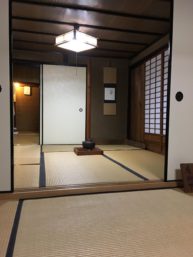
Second Tea Ceremony Room
Over the fall of 2018 my CIP was attending tea ceremony lessons. At first, I experienced how tightly knit the tea ceremony community is, because it took a couple of lessons before the teacher and other students stopped keeping me at distance. They treated me as an outsider not to be mean nor discourage me, but because we had not yet developed a feeling of closeness and had no shared experiences. As I observed, the students closest to the tea teacher still used desu/masu and even keigo regularly when talking to or about her, but what they talked about and the relaxed atmosphere in which they communicated reflected their closeness. For instance, the teacher would casually, in plain form or desu/masu, discuss with more experienced students the price of new tatami, private tea gatherings she attended, or what previous students. Their discussions are always quite happy, warm, and friendly.
By comparison, the teacher only talked to the less experienced students, who had spent less time learning tea there, about the tea ceremony, and their discussions always happened in a more formal atmosphere. Over the course of the semester, all students, including myself, continued to develop closer ties to the teacher. And so, I, and others, slowly developed close enough ties to be considered more of an inside member of their close-knit group, and the formal and distant treatment at the beginning slowly melted away quite a bit. So, I now look forward to continuing developing closer ties and slowly becoming more a part of their inner world of tea. So, I encourage other students who may at first experience a colder or more distant reception to not be discouraged. The strictness, formality, and distance in small groups like the tea ceremony are only signs of how close-knit the group is, with bonds going years or generations back. If you are sincere in your efforts to try your best, then once they get to know you, they will begin to warm up to you.
With the above in mind, I learned, practiced, and observed a great deal of keigo as well as the many intricate manners for interacting in Japan, which became a great help in many other interactions beyond my lessons. When switching between receiving instruction and actually participating in the tea ceremony, I was able to gain more experience in knowing what keigo was used in place of other words in various situations. Likewise, I learned that there are many ways of showing gratitude to your sensei, or superior, beyond saying thank you and bowing. For instance, very long letters are written yearly by students to express their gratitude, and these letters must use certain kinds of paper, language, and multiple forms of saying thank you. Similarly, gifts of sweets or gratuity money are not required but seen as signs of gratefulness towards the teacher, and these signs of gratitude must be presented in a certain way as a gesture of respect. For instance, monthly lesson fee payments must be made of crisp bills and be placed in a crisp, new envelope. This envelope must be placed on a fan and presented in front of the teacher using a set phrase and bowing, usually while sitting seiza style. Later I learned many of these rules and gestures can be helpful in other kinds of everyday situations with people with which you are not close, business situations, and school situations. So, they were all very helpful to learn.

Wow, this is such a cool window into the world of tea ceremony! It sounds like you learned a lot. I’m impressed that you kept at it even though it seems to be a fairly formal and intimidating group!
Yeah, despite the initial barriers, it was a fantastic experience, and I’m glad I stuck with it.